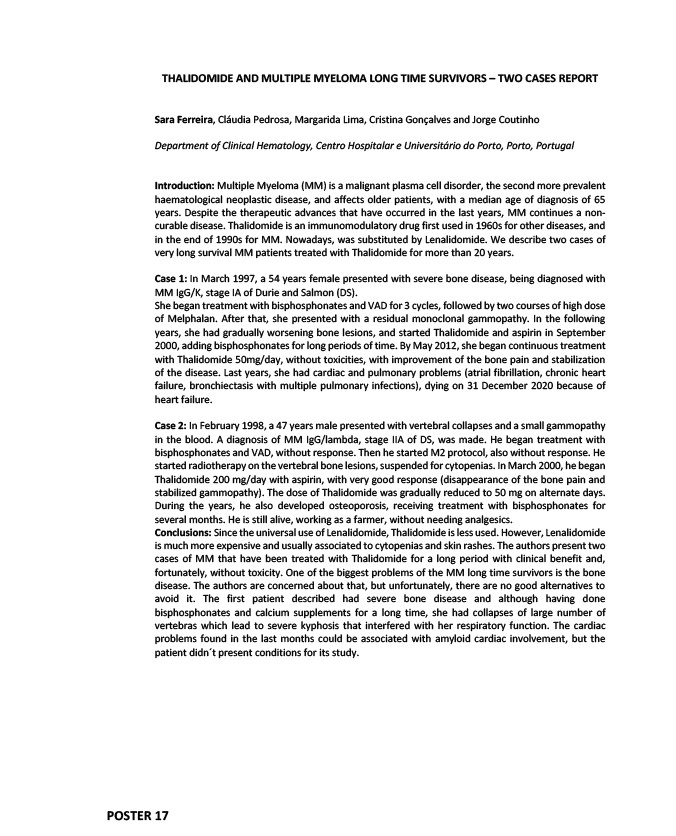
THALIDOMIDE AND MULTIPLE MYELOMA LONG TIME SURVIVORS – TWO CASES REPORT
Sara Ferreira, Cláudia Pedrosa, Margarida Lima, Cristina Gonçalves and Jorge Coutinho
Department of Clinical Hematology, Centro Hospitalar e Universitário do Porto, Porto, Portugal
Introduction: Multiple Myeloma (MM) is a malignant plasma cell disorder, the second more prevalent
haematological neoplastic disease, and affects older patients, with a median age of diagnosis of 65
years. Despite the therapeutic advances that have occurred in the last years, MM continues a non-curable
POSTER 17
disease. Thalidomide is an immunomodulatory drug first used in 1960s for other diseases, and
in the end of 1990s for MM. Nowadays, was substituted by Lenalidomide. We describe two cases of
very long survival MM patients treated with Thalidomide for more than 20 years.
Case 1: In March 1997, a 54 years female presented with severe bone disease, being diagnosed with
MM IgG/K, stage IA of Durie and Salmon (DS).
She began treatment with bisphosphonates and VAD for 3 cycles, followed by two courses of high dose
of Melphalan. After that, she presented with a residual monoclonal gammopathy. In the following
years, she had gradually worsening bone lesions, and started Thalidomide and aspirin in September
2000, adding bisphosphonates for long periods of time. By May 2012, she began continuous treatment
with Thalidomide 50mg/day, without toxicities, with improvement of the bone pain and stabilization
of the disease. Last years, she had cardiac and pulmonary problems (atrial fibrillation, chronic heart
failure, bronchiectasis with multiple pulmonary infections), dying on 31 December 2020 because of
heart failure.
Case 2: In February 1998, a 47 years male presented with vertebral collapses and a small gammopathy
in the blood. A diagnosis of MM IgG/lambda, stage IIA of DS, was made. He began treatment with
bisphosphonates and VAD, without response. Then he started M2 protocol, also without response. He
started radiotherapy on the vertebral bone lesions, suspended for cytopenias. In March 2000, he began
Thalidomide 200 mg/day with aspirin, with very good response (disappearance of the bone pain and
stabilized gammopathy). The dose of Thalidomide was gradually reduced to 50 mg on alternate days.
During the years, he also developed osteoporosis, receiving treatment with bisphosphonates for
several months. He is still alive, working as a farmer, without needing analgesics.
Conclusions: Since the universal use of Lenalidomide, Thalidomide is less used. However, Lenalidomide
is much more expensive and usually associated to cytopenias and skin rashes. The authors present two
cases of MM that have been treated with Thalidomide for a long period with clinical benefit and,
fortunately, without toxicity. One of the biggest problems of the MM long time survivors is the bone
disease. The authors are concerned about that, but unfortunately, there are no good alternatives to
avoid it. The first patient described had severe bone disease and although having done
bisphosphonates and calcium supplements for a long time, she had collapses of large number of
vertebras which lead to severe kyphosis that interfered with her respiratory function. The cardiac
problems found in the last months could be associated with amyloid cardiac involvement, but the
patient didn´t present conditions for its study.